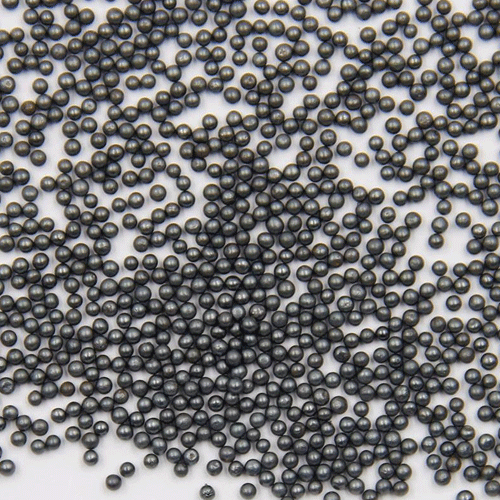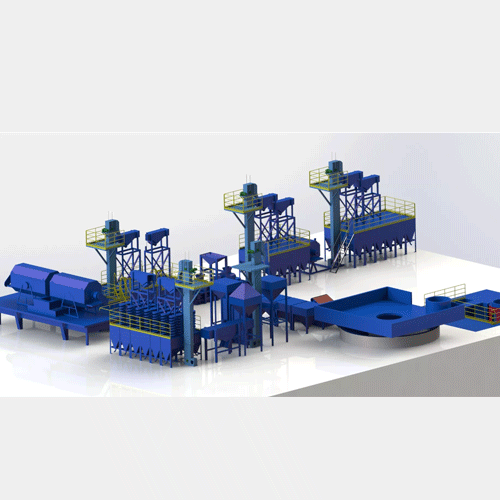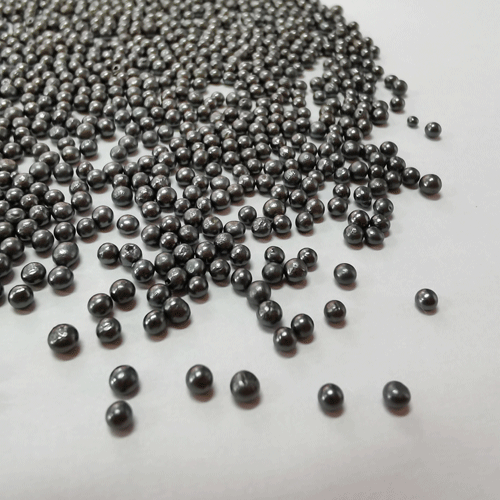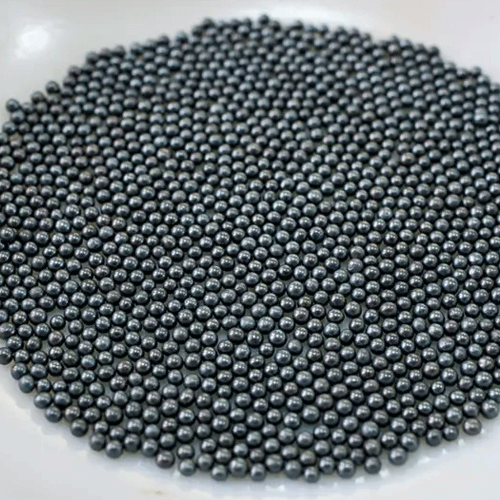Shot peening is a process that uses sand and iron shots ejected at high speed to impact the surface of the workpiece to improve some of the mechanical properties of the part and change the surface state. Shot peening can be used to improve the mechanical strength of parts as well as wear resistance, fatigue resistance and corrosion resistance. It can also be used for surface matting, removing scale and eliminating residual stress in castings, forgings and weldments. The main classification of shot peening is divided into shot peening and sand blasting. Surface treatment with shot blasting has strong impact and obvious cleaning effect. However, the treatment of thin plate workpieces by shot blasting can easily deform the workpiece, and the steel shot hits the surface of the workpiece (regardless of shot blasting or shot peening), causing the metal substrate to deform. Since Fe3O4 and Fe2O3 have no plasticity, they peel off after being broken, and the oil film is The base material deforms at the same time, so for workpieces with oil stains, shot blasting and shot blasting cannot completely remove the oil stains. Among the existing workpiece surface treatment methods, sandblasting has the best cleaning effect. Sandblasting is suitable for cleaning workpiece surfaces with high requirements. However, most of the current general sandblasting equipment in my country consists of primitive and heavy sand conveying machinery such as augers, scrapers, and bucket elevators. The user needs to build a deep pit and a waterproof layer to install the machinery. The construction cost is high, and the maintenance workload and maintenance costs are huge. A large amount of silica dust is generated during the sandblasting process and cannot be removed, which seriously affects the health of operators and pollutes the environment. . Shot peening is divided into general shot peening and stress peening. During general processing, when the steel plate is in a free state, high-speed steel shot is used to hit the inside of the steel plate to generate pre-pressure stress on the surface. To reduce the tensile stress on the surface of the steel plate during operation and increase the service life. Stress shot peening is to pre-bend the steel plate under a certain force and then perform shot peening.
Classification of shot peening equipment There are two main types of shot peening equipment:
1. Mechanical centrifugal shot peening machine, which is suitable for parts that require high shot peening intensity, few varieties, large batches, simple shapes, and large sizes.
2. Pneumatic shot peening machine (compressed air type), suitable for parts that require moderate shot peening intensity, complex shape, and small size.
Introduction to shot
1. The hardness of cast steel shot is generally 40~50HRC. When processing hard metal, the hardness can be increased to 57~62HRC. Cast steel shot has better toughness and is widely used. Its service life is several times that of cast iron shot.
2. Cast iron shot has a hardness of 58~65HRC, which is brittle and easy to break. It has a short life and is not widely used. Mainly used in situations where high shot peening intensity is required.
3. The hardness of glass shot is lower than the first two. It is mainly used for titanium, aluminum, magnesium and other materials that do not allow iron contamination. It can also be used for secondary processing after steel shot peening to remove iron. Contaminate and reduce the surface roughness of parts.
4. Ceramic pellets The chemical composition of ceramic pellets is roughly 67% ZrO2, 31% SiO2 and 2% Al2O3-based inclusions. It is made by melting, atomizing, drying, rounding and screening. The hardness Equivalent to HRC57~63. Its outstanding properties are higher density and higher hardness than glass. It was first used to strengthen aircraft parts in the early 1980s. Ceramic pellets have higher strength, longer life than glass pellets, and lower prices. They have been extended to surface strengthening of non-ferrous metals such as titanium alloys and aluminum alloys.
Introduction to the shot peening machine nozzle
1. Straight barrel nozzle The straight barrel nozzle has a simple structure, and its internal structure only has two parts: a contraction section and a straight section.
2. Venturi-shaped nozzle The Venturi-shaped nozzle is structurally divided into three parts: a contraction section, a straight section and a diffusion section, which significantly increases the difficulty of manufacturing.
3. Double Venturi-shaped nozzle The double Venturi-shaped nozzle has two nozzles at the front and rear. There is a gap between the two, and there are several small holes around the gap.
4. Square hole nozzle Currently, a nozzle with a square inlet end and an outlet end has been developed abroad. Various tests have shown that this nozzle works more efficiently and is more economical than a Venturi-shaped nozzle.
Parameters that affect shot peening quality
1. Shot peening intensity. The process parameters that affect shot peening intensity mainly include: projectile diameter, projectile velocity, projectile flow rate, shot peening time, etc.
2. Coverage Factors that affect coverage: hardness of part material, Projectile diameter, injection angle and distance, shot peening time, etc.
3. Surface roughness Factors affecting roughness: strength and hardness of the part material, projectile diameter, injection angle and speed, original surface roughness of the part After shot peening The size of the residual compressive stress on the sprayed surface of characteristic parts and the depth of the compressive stress layer depend on the properties of the sprayed material and the shot peening intensity. The higher the strength and hardness of the material, the greater the compressive stress and the shallower the depth of the compressive stress layer. The higher the shot peening intensity, the greater the depth of the compressive stress layer. The material structure of the sprayed surface layer changes. The sprayed surface changes. Gotta be rough. The roughness of the blasted surface becomes worse as the shot peening intensity increases, the surface hardness decreases, and the shot size decreases. Increased size. The metal on the sprayed surface is extruded, forming tiny metal crests, so the size increases. Shot peening application range Shot peening can prevent bending fatigue of automobile parts; shot peening can improve the bending fatigue properties of the tooth profile root; shot peening can improve the fatigue resistance and safe service life of the crankshaft; shot peening can increase the length of the connecting rod Strength and stiffness; the powerful shot peening process can improve the bending fatigue strength and contact fatigue strength of the gear teeth, which is an important way to improve the anti-biting ability of the gear and increase the life of the gear; surface shot peening is to improve the stress resistance of fasteners against fatigue fracture An effective surface strengthening process to prevent corrosion and hydrogen embrittlement fracture. After shot peening, the reliability and durability of the workpiece can be significantly improved; surface shot peening improves fatigue performance (including stress corrosion performance) by changing the structure of the material, which can improve the quality of fasteners.
 Metal surface shot peening process
Metal surface shot peening process
 Grinding Applications in the Automotive Industry
Grinding Applications in the Automotive Industry
 Tips and features for using shot blasting machine steel shots
Tips and features for using shot blasting machine steel shots
 Applications of low carbon steel shot
Applications of low carbon steel shot